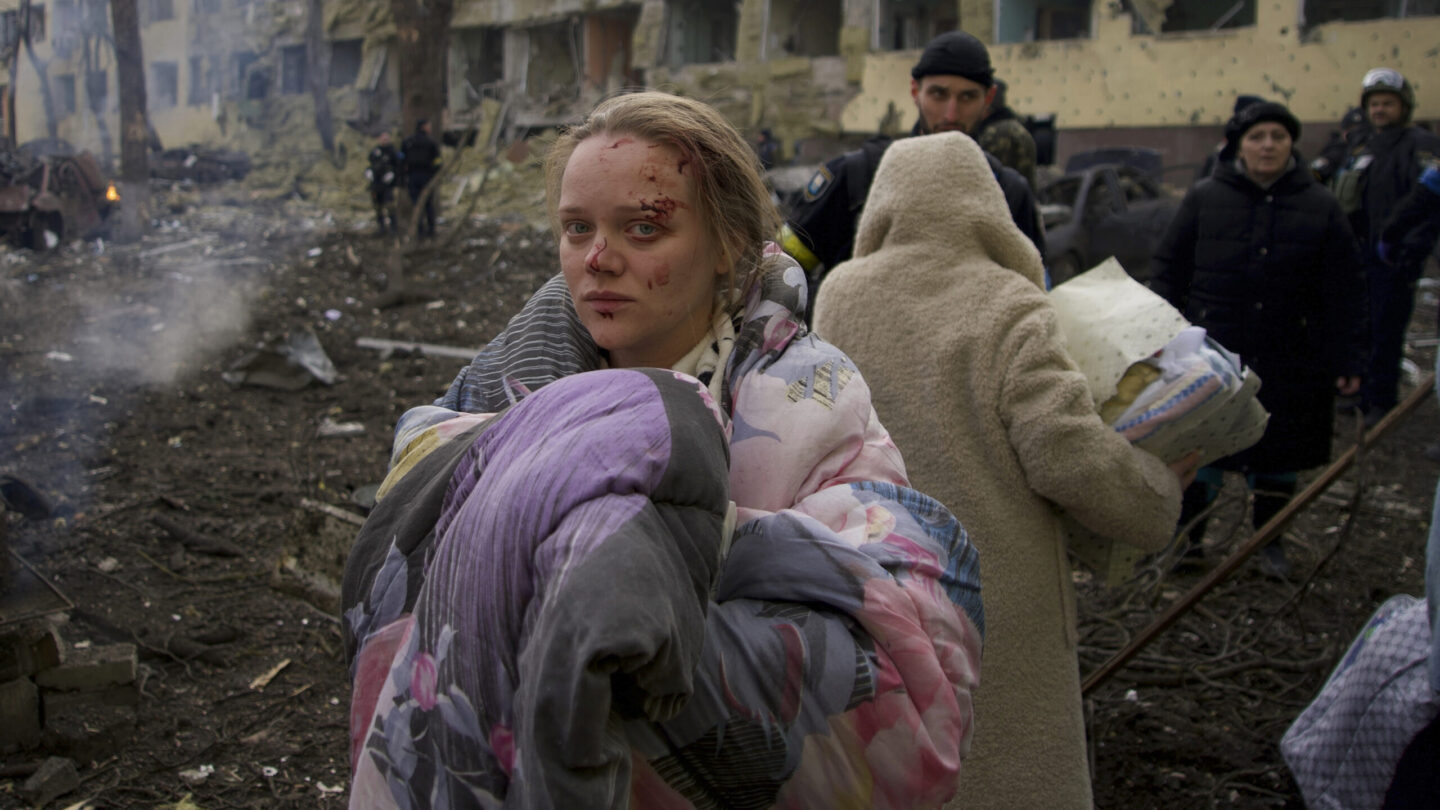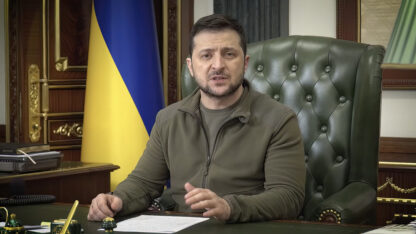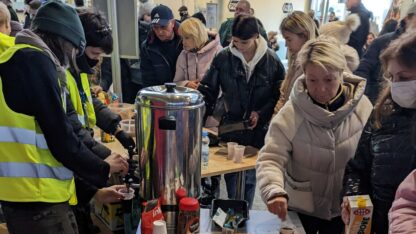The immediate toll of the Russian airstrike that devastated a maternity hospital in the Ukrainian city of Mariupol last week was three people dead and 17 injured, but the impact did not stop there. In the AP photo that has come to symbolize the attack, a wounded pregnant woman lies on a stretcher, holding her lower belly and splattered with blood, being rushed out of the hospital by emergency workers seeking care for her elsewhere. Neither she nor her baby survived.
The attack was condemned worldwide. The World Health Organization issued a statement: “To attack the most vulnerable – babies, children, pregnant women, and those already suffering from illness and disease, and health workers risking their own lives to save lives – is an act of unconscionable cruelty.”
WHO further pointed to the ongoing ripple effects such attacks pose by — limiting access to health care as well as potentially endangering those who seek it and also straining and threatening the viability of the health-care system itself.
Yet this was only one of 31 attacks on health-care workers, medical sites and facilities documented thus far in the Ukraine conflict by WHO’s Surveillance System for Attacks on Health Care (SSA). Moreover, health facilities have been targeted in other wars, including those led or supported by Russia, like Syria’s ongoing civil war and the war in Chechen from 1999 to 2009.
What happens to the health needs of the local population in the short-term – and what are the long-term consequences of this kind of destruction? How can what happened in past conflicts help us gain insight into the plight of those in Ukraine now?
To learn more, we spoke with Leonard Rubenstein, professor at the Johns Hopkins University school of public health and author of Perilous Medicine: The Struggle to Protect Health Care from the Violence of War; Dr. Michele Heisler, medical director at Physicians for Human Rights and a professor of internal medicine and of public health at the University of Michigan; and Dr. Houssam al-Nahhas, the Middle East and North Africa researcher at Physicians for Human Rights. Their comments have been edited for length and clarity.
Physicians for Human Rights has documented 601 deliberate attacks on 350 medical facilities in Syria from 2011 onward. Why target medical facilities?
Heisler: It is a devastatingly effective weapon of war because there are few greater ways of terrorizing the population, of breaking their will and lowering morale, than through attacking health care. An article in The Lancet called this strategy “the weaponization of health care.”
Al-Nahhas: When a country attacks health-care facilities they are sending the message that they don’t have any boundaries to what they can do. This is targeting people who cannot defend themselves and who cannot pose a threat because they’re patients. It is a way to break people’s resilience. Going to the hospital becomes dangerous, going there to get help means risking your life.
Was that one of the immediate consequences you saw in Syria and elsewhere?
Al-Nahhas: We documented this in a case history of what happened after three airstrikes hit al-Altareb hospital in Aleppo in March 2021. Afterward, there was a significant decrease in consultations and beneficiaries of health care due to the risk of being bombed at the facility.
There was a decrease of 78% of prenatal and reproductive care consultations. We also witnessed a 27% decrease in normal deliveries. Many would elect to do a C-section in order to know when they will come in and when they will go out and to limit the time spent in the facility.
That is also what I witnessed in Aleppo during my time there as an emergency physician between 2014 and 2016, when we saw a spike of C-sections in conjunction with military escalations in 2014.
What else happens when health-care facilities are attacked?
Heisler: In the short-term there is chaos. Supplies, medications, oxygen are in short supply. People are not getting IV fluids or necessary surgery or other treatments, such as dialysis, and there are needless deaths as a result.
Rubenstein: On top of that, the hospitals may not have a track record of dealing with the complex injuries resulting from these powerful weapons. There may also be fewer staff members. In Syria, many of the most experienced physicians left, leaving behind the less experienced and younger physicians. There was an effort at quick training and a shifting of inexperienced people doing more complex things. For instance, technicians who supported the anesthesiologists may have to do the anesthesia or dentists [may have to] do oral surgery.
Are there additional ramifications for health care as the conflict continues?
Rubenstein: Childhood vaccinations tend to decline because the vaccinators are attacked — as in Afghanistan — and whole vaccine initiatives have to be suspended. Measles vaccinations have to be suspended either because of attacks on the vaccinators or because of the general insecurity, where it’s too dangerous to go house to house. Attacks on a health-care facility in Zemio in Central African Republic [in 2017] led to HIV and AIDS programs being suspended.
In Yemen the Saudis have bombed both hospitals and water and sanitation infrastructure, such as pumping plants, which then led to a cholera epidemic that affected more than 2 million people.
Heisler: In Syria, hospitals went underground. You go from flying the white flag and when you realize that might indeed be a target, you take down the flag and you go underground. In Syria there was a whole system of underground hospitals.
Al-Nahhas: If all the intensive care units are occupied by people with war injuries, that equipment is not available to be used to help COVID patients or heart patients or any non-war related illness.
And what longer term consequences have you seen from such attacks?
Rubenstein: Even after a conflict ends it often takes a very long time to restore health capacity. And in the meantime people’s health continues to suffer in ways similar to during the conflict.
Heisler: The concern is this might lead to the complete collapse of the health-care system. The continuing shortage of health-care workers and no supplies and no system to provide necessary care — that is devastating. In Yemen, and in Tigray [Ethiopia, where a war began in 2020 and is still going on] almost all health-care systems are not functioning.
What about the impact on the physicians and health-care workers? The stress must be acute.
Al-Nahhas: I think it’s important for people to know what the health-care workers are experiencing in Ukraine — especially when health care is not protected in conflict.
It’s knowing that you are in a hospital and treating patients and yet you can be targeted and killed at any moment. You need to provide the best care for your patients but you’re also worried about your own safety.
I was in Syria for two years literally living in the hospital. It was rewarding to see the impact of [our] the work on people, but it was not sustainable because of the stress on all the health-care providers. We were not used to seeing so much trauma. We had to learn as we went along how to treat war-related injuries that we had never seen before.
This sense of how bad things can get — the flashbacks from Syria — are still with me after eight years.
What is being done to stop such attacks? Three international courts are now investigating possible war crimes committed by Russia in Ukraine. Could that make a difference?
Heisler: We need to establish accountability by documenting and gathering evidence of what has happened. That is the role of organizations like ours. If we live in a world in which you can bomb hospitals in war, killing patients and health-care workers, then we really would be returning to no-holds barred wars where no one is safe. We have to be sure that this does not continue.
Diane Cole writes for many publications, including The Wall Street Journal and The Washington Post. She is the author of the memoir After Great Pain: A New Life Emerges. Her website is DianeJoyceCole.com.
Copyright 2022 NPR. To see more, visit https://www.npr.org.
9(MDAxODM0MDY4MDEyMTY4NDA3MzI3YjkzMw004))

9(MDAxODM0MDY4MDEyMTY4NDA3MzI3YjkzMw004))









